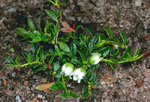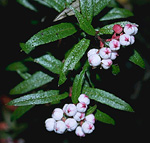 |
The Ericaceae can be regarded as an extra-Australian equivalent of the
characteristically Australian family Epacridaceae. Few species occur here,
and these are relatively localised in wet-sclerophyll forests or high-altitude,
cool rain forests from Tasmania to north Queensland. A few species of
Erica are naturalised and occur as weeds of roadsides in the southern
States.
Characteristic features of the family Ericaceae in Australia include: - shrubs or small trees with broad, alternate or whorled leaves, usually acute but not sharply so
- flowers often showy, tubular or cup-shaped with 4-5 fused petals, red, pink or white
- anthers usually twice the number of petals, often with appendages, dehiscing by terminal pores or longitudinal slits
- ovary superior; fruit a berry or fleshy or dry capsule
Description
Evergreen shrubs or rarely trees. Internal secretions not obvious. Plants glabrous or with simple, non-glandular, ?unicellular or uniseriate hairs. Leaves alternate and spiral, opposite, or in whorls of 3 or 4, petiolate, rarely subsessile or sessile; pulvinae rarely present. Stipules absent. Lamina simple, symmetric, filiform, acicular, subulate, linear, lanceolate, ovate, elliptic or orbicular; margins entire or serrate, ±flat, revolute or recurved; one-veined, or the venation pinnate, with the midrib conspicuous or inconspicuous, and the tertiary venation not reticulate; surfaces punctate or not punctate; herbaceous or leathery. Usually all the flowers bisexual. Inflorescences terminal or axillary, consisting of racemes, panicles, corymbs, umbels or solitary flowers. Bracts present. Bracteoles ?present or absent. Flowers odourless or fragrant, stalked. Floral disc present; nectaries present on the disc. Perianth of 2 dissimilar whorls, imbricate or valvate in bud. Calyx regular; segments free or fused, with 4–5 (–7) sepals or lobes; calyx cup-shaped, bell-shaped or funnel-shaped, herbaceous or succulent. Corolla regular; segments fused, with 4–5 (–7) lobes, alternating with the sepals or calyx lobes; corolla bell-shaped, urn-shaped or tubular, white, cream, red or pink, without contrasting markings, membranous; lobes ±entire. Fertile stamens (4–5) 8 or 10, both opposite to and alternating with the sepals or calyx lobes, apparently free of or rarely at least partly fused to the corolla, free of the ovary and style, distinct from each other, all ±equal. Anthers dorsifixed, versatile, opening terminally by pores or rarely longitudinal slits, 2-celled; appendages apical or basal. Ovary superior and sessile, or inferior. Carpels 4–5, fused; ovary with 4–5 locules. Style terminal, single and unbranched, or branching from the base. Ovules 1–numerous per locule, sessile; placentation axile. Fruit a dry, dehiscent, septicidal or loculicidal capsule or a fleshy, indehiscent berry or a drupe; the perianth on the maturing fruit deciduous or dry and persistent. Disseminule micro-surface ±reticulate or granulate, white, cream, red or pink, glossy or dull. Seeds 5–numerous per fruit. Aril absent. Cotyledons 2. Embryo straight.
(Note: this description has been generated from the coded data compiled for the key. Any errors in the key data will be reflected in the descriptions.)
A treatment of the family Ericaceae has not yet been published in the Flora of Australia. It will appear in Volume 9.
Australian genera of Ericaceae (as recognised for the Flora of Australia)
* = all species introduced
Agapetes
*Arbutus
*Calluna
*Erica
Gaultheria
Pernettya
Rhododendron

|
  |

Agapetes meiniana (flowers)
Photo: H.Nicholson © H. & N. Nicholson

Agapetes meiniana (flowers)
Photo: M.Fagg © ANBG

Gaultheria (Pernettya) tasmanica (flowering plant)
Photo: M.Fagg © M.Fagg

Gaultheria appressa (fruits)
Photo: H.Nicholson © H. & N. Nicholson

|
 |
|